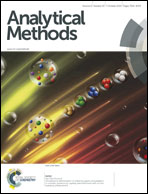Metabolomic analysis provides novel chemotaxonomic characteristics for phenotypic cultivars of tree peony†
Abstract
Metabolomic analysis is an important molecular phenotyping method for understanding plant ecotypic variations. Here, we systematically characterized the metabolomic variations associated with five Chinese cultivars of tree peony (Paeonia suffruticosa Andrews) using high performance liquid chromatography-mass spectrometry (HPLC-MS) and multivariate data analysis. Our results indicated that the metabolite profile of the root bark in tree peony was largely dominated by 5 primary metabolites and 41 secondary ones including 7 phenolics, 7 flavonoids, 16 monoterpene glycosides and 11 acetophenones. The distribution of these secondary metabolites varied in the different tree peony cultivars. Some secondary metabolites, such as galloyl glucoses, procyanidins, mudanpiosides and acetophenones, will become the novel and potential chemotaxonomic markers to differentiate tree peony cultivars when the conventional classification methods are not practicable. These results demonstrated that HPLC-MS based metabolomics was an effective tool for the classification of phenotypic cultivars and provided novel and potential chemotaxonomic characteristics of tree peony.


 Please wait while we load your content...
Please wait while we load your content...